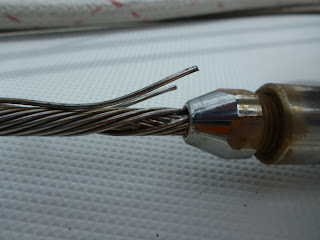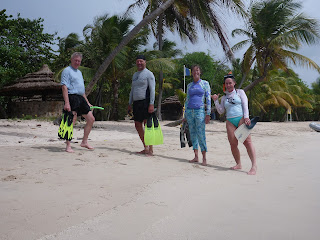But before i go there, i have to share Sara and Patricia’s
antics with the flamingoes in Aruba.
The Renaissance hotel and marina where we stayed has water taxis that
run their guests out to their private island, where there are flamingoes. Fun!
Let’s see, how’d we get here? We cleared customs in Aruba, hoisted the jib (on the
repaired solent stay) at noon, and took off in comfort on a broad reach with a
lot of wind. “And…(imagine the
announcer’s voice at the race track)…they’re off!” (Tyler authored this…whenever it could be true). We drug a new lure behind Akimbo and
settled into our watch schedule.
The average age of this crew would be the oldest of the trip, i would be
the youngest aboard, and this stretch of the Colombian coast is respected as
very windy. By afternoon the wind
settled down and we were sailing with the genoa alone (larger than the jib) and
we had fresh mahi mahi chilling for dinner.
The forecast spoke of no squalls. A near full moon rose.
The genoa carried us into the night.
Sailing into the wind feels much windier than sailing with
it. I usually pick conservative
sail combinations by considering what sails i would want if i HAD TO turn
around and sail upwind. I.E. if
someone fell overboard. While i
wasn’t trying to be aggressive about our progress and the genoa felt almost
over-powering, even downwind, the key word here is “almost.” I gave us permission to make good speed
by telling myself we could always roller furl half the sail up if we needed
to. Combined with building swells,
we touched well over 10 knots repeatedly for a little while
that night. Noon to noon, we made
a 151nm. It was a good pace and
had been comfortable. It’s what
i’m aiming for on the Panama-Hawaii leg.
The next day we caught and released a small tuna. The wind dropped some and we put the
drifter up. Later in the day a
school of porpoise played with us…for about an hour! They leaped clear of the water, one turned over to land on
its back, they turned on their sides and looked directly into our eyes. I’d swear they like an audience. Again i was addicting to the boat’s speed. The drifter carried us in more and more
wind until near sunset. We took it
down and unrolled the genoa for the night.
There had been little freighter traffic the night before,
but this night there was a smallish one that confused us. When we first sighted his lights in the
distance, he was dead ahead of us.
We altered course a little to miss him…and he altered course to
intercept us. We altered more, he
altered more. The wind was
light. Neither of us was moving
fast, but as we got closer to him, i turned on the engine in case we might need
it to dodge him? He flashed a
spotlight our way a few times. I
flashed our light back at him.
When his bow and stern were clear to me, we made a sharp turn and sped
the engine up to pass off his stern.
At that point he seemed to lose interest and soon disappeared behind us,
going in the opposite direction.
The wind dropped faster than the size of the waves. Thus, the waves rolled Akimbo, which would wag the mast and shake the wind out of the genoa. Then when the sail refilled it would
slam full and give the whole rig (and boat) a violent shake. Torture and abuse. As the wind went lighter, our speed
under three knots was not worth this wear and tear…on the sail, on the boat and
on us. We motored for about three
hours. When the sun came up, so
did the wind…in better proportion to the wave size…and we were sailing
again.
We had another hundred miles left to go. If our average speed continued, we
risked arriving at Cartagena in the dark, before the next sunrise. We were tired. And the only cruisers’ notes i had
found about cruising in Colombia spoke well of the five bays we were about to
pass by on this coast.
Improvising, we decided to anchor in one of them to give everyone a
rest, eat a quiet meal, snorkel and nap.
Plus it didn’t seem fair to take this crew from a dock in Aruba to
another dock in Cartagena. This
stop confirmed for us that cruising is NOT about the cities and docks but about
the remote anchorages in between (especially the ones accessible only by boat). After 6 hours, we hoisted
the jib and were off again.
Late that afternoon, after a nap, i felt remiss about not having
done a man overboard drill with this crew. Something i had done smoothly with every crew so far. Little did i know that chaos was about
to win this round. I was about to
show my crew how NOT to rescue a man overboard. What? It’s
important that i write this down, because i want my previous crews to know when
this method won’t work.
The MOB drill from hell: we were on a broad reach in about 20 knots of wind with the
jib alone up. I spun the boat up
into the wind. Took advantage of
the slack jib sheet to haul it in.
The jib went aback. I
tossed out the Lifesling. It was
soon towing behind. (minor
item: i forgot we were towing a
fishing line…but then that would probably happen in a real MOB situation). I gybed the boat around, the jib filled and we sailed back past the swirl we had left in the water with our original
turn. I tried sailing upwind, jib
alone, enuf to come about again, jib aback, and NOT pass downwind of our
target. This is what failed. We not only missed our target, we ran
over the Lifesling’s rope (and our fishing line), which got caught and
jammed under Akimbo.
How would i do this drill differently? Why didn’t it work? It didn’t work because we had no
mainsail up to balance against the pressure in the jib. The jib aback dragged us too far
downwind. Part of what i like most
about this system is keeping it simple, not having to actually trim sails. But, in this situation, the
first solution i would choose would be to actually tack the jib and sail the
boat (if it had been the genoa up alone, with the fairleads forward for reaching...move the fairleads aft for beating and then sheet in). I think that would
work. The other possible answer
would be to roll up or drop the headsail, make sure no lines are in the water
and under the boat, start the engine and circle the person in the water with
the Lifesling. In both solutions,
when the person reaches the Lifesling, drop (or furl) sail…or in solution 2,
turn off the engine.
In both situations, if you have enuf crew: 1. of course
assign someone to not take their eyes off the person in the water; and 2. the
original and immediate turn up into the wind keeps the boat very near that
person anyway.
Okay, there.
I’ve done my duty to write about this. I won’t elaboarate on dropping sail, losing backstay
pressure, pumping it back up, getting out the compressor, putting on a mask,
setting up a belay, diving under the boat in 4 to 5 foot seas, clearing the
Lifesling line (and fishing line) from the propeller in just a few minutes,
putting all this away, rehoisting and getting back underway (not to mention other details). I’m sure my crew were convinced that
falling overboard is a death sentence and swore to themselves to not let it happen.
We sailed thru another night, more and more glows from cities ashore watching us go by. At one point i
found us sailing thru a fishing fleet of seven or so boats. I noticed a few red flashing lights in
the water and guessed each was at the end of a fishing net. We got thru them
without running over a net and carried on. One thing we found is that as the wind dropped and seas had
yet to…the jib didn’t slam back and forth like the genoa would have. Don’t know why this is the case, but we
appreciated it.
Thru the morning we chased a dying wind. Unrolled the genoa, but soon rolled it
back up and motored a few more hours.
At noon an onshore wind started up, we unrolled the genoa and sailed into Cartagena in style. The approach is
interesting. One of the defenses constructed to stop the attacks on the city by Sir Francis Drake way
back when is an underwater wall across one of the entrances. Very effective, eh? The wall hidden from view, an attacking
and unknowing vessel sailing in only to wreck on the wall. Now there is a narrow gap in the wall,
marked by buoys, which we took advantage of (since it was daylight) and
appreciated – saving us two or three hours to sail around an island and into
the unobstructed south entrance.
We muddled about in the harbor, got no replies on our vhf
radio as we hailed different marinas…waved down a few people on a dock and
ended up in the ritziest place in town: a private yacht and fishing club whose facilities have expanded upon some 17th century fortifications (photo above). Nice showers, a bartender with a great smile...and neighbors/new friends at the end of the dock, skilled boatwrights restoring a 45 year old wooden schooner... Dumb luck.
What are all the details in between? I know i am forgetting to tell
them. Maybe they’ll come to me
later. Cartagena’s fortifications
date from the 1600s and some of its modern architecture is lovely. In the old town, homes and restaurants
and shops front right up against the sidewalks so that they can enclose their
own quiet courtyards. Love
that. Patricia is collecting photos
of the huge variety of door knockers.
The tourists here are Colombian (except for us). This IS a charming, lively city worth visiting
for a few weeks rather than a few days, much of which i’ve occupied with chores
on Akimbo.
Thank you Sara, Patricia and Ryan. Each night there was something easily missed that could have
been dangerous if i were alone. We
did well, had fun, and made yet another rendezvous on time. Welcome aboard Rima.
The San Blas Islands are remote and will be our home for the next three weeks. I don't expect internet access until we arrive at Shelter Bay Marina and stage for the Panama Canal. I'll hope to post the next entry from there. Meantime, be well and enjoy.

















































